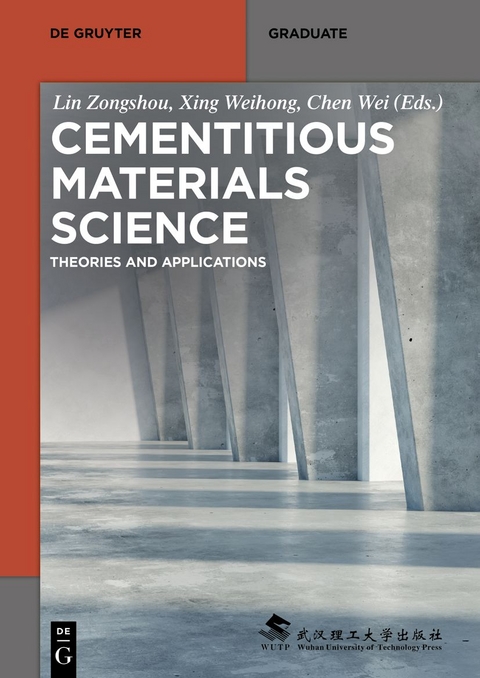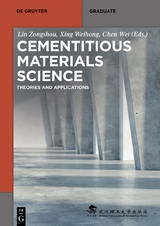Cementitious Materials Science
With a focus on portland cement, the book systematically illustrates the composition, properties, and applications of different kinds of cementitious materials, and presents their reaction during the hydration and hardening process. The production technique and applied technology are also discussed with examples. Exercises are added in each chapter, making the work an essential textbook for students.
Zongshou Lin, Wuhan University of Technology, Wuhan, China
Contents
Introduction
1 General Portland Cement
1.1 Invention and technological process of cement
1.1.1 Invention of cement
1.1.2 Technological process of cement
1.2 Composition of Portland cement clinker
1.2.1 Chemical component and mineral composition of clinker
1.2.2 Ratio value of clinker
1.2.3 Calculation of clinker's mineral composition
1.3 Raw materials and raw material proportioning of Portland cement
1.3.1 Raw materials of cement
1.3.2 Composition design of clinker
1.3.3 Computation of raw material proportioning
1.4 Calcination of Portland cement clinker
1.4.1 Desiccation and dehydration
1.4.2 Carbonate decomposition
1.4.3 Solid-phase reaction
1.4.4 Sintering of clinker
1.4.5 Cooling of clinker
1.4.6 Functions of other components
1.4.7 Main equipment for clinker's calcination
1.5 Production and standard of general Portland cement
1.5.1 Cement mixing materials
1.5.2 Definition, categories and technical requirements of general Portland cement
1.5.3 Limestone Portland cement
1.5.4 Grinding of cement
1.6 Hydration and hardening of general Portland cement
1.6.1 Hydration of clinker minerals
1.6.2 Hydration of Portland cement
1.6.3 Hydration and hardening of blended Portland cement
1.6.4 Hydration rate
1.6.5 Hardened cement paste
1.7 Properties of Portland cement
1.7.1 Density and volume density
1.7.2 Fineness
1.7.3 Consistency and fluidity of water demand
1.7.4 Condensation time
1.7.5 Intensity
1.7.6 Volume change
1.7.7 Water retention and segregation
1.7.8 Heat of hydration
1.7.9 Heat resistance
1.7.10 Anti-permeability
1.7.11 Frost-resistance
1.7.12 Corrosion resistance
Exercises
2 Characteristic cement and special cement
2.1 Aluminate and high-temperature cement
2.1.1 Aluminate cement
2.1.2 Phosphoric acid and phosphate refractory castable
2.1.3 Water glass refractory castable
2.2 Fast hardening and high strength cement
2.2.1 Fast hardening Portland cement
2.2.2 Fast hardening sulphoaluminate cement
2.2.3 Fast hardening ferrous aluminate cement
2.2.4 Fast hardening fluoraluminate cement
2.2.5 Fast hardening and high strength aluminate cement
2.2.6 Ultra-fast hardening coagulation aluminate cement
2.3 Anti-sulfate cement, moderate- or low-heat cement and road cement
2.3.1 Anti-sulfate cement
2.3.2 Moderate- or low-heat cement Portland cement, low-heat slag cement
2.3.3 Low-heat slight expansive cement
2.3.4 Low-heat slag Portland cement
2.3.5 Road Portland cement
2.3.6 Slag road cement
2.4 Expansive and self-stressing cement
2.4.1 Basic principles of producing expansive cement
2.4.2 Categories of expansive cement
2.4.3 Production and properties
2.5 Oil well cement
2.6 Decoration cement
2.6.1 White Portland cement
2.6.2 Colored cement
2.7 Masonry cement
2.7.1 Masonry cement GB/T 3183-2003
2.7.2 Slag masonry cement JC/T 1090-2008
Exercises
3 Gypsum
3.1 Raw materials of gypsum
3.1.1 Natural gypsum
3.1.2 Industrial by-produced gypsum
3.2 Production of gypsum plaster
3.2.1 Dehydration and phase transition of gypsum
3.2.2 Preparation of hemihydrate gypsum
3.3 Building gypsum
3.3.1 Production of building gypsum
3.3.2 Properties and its affecting factors of building gypsum
3.4 Hydration and hardening of hemihydrate gypsum
3.4.1 Hydration of gypsum binding materials
3.4.2 Hydration process and hardening mechanism of dehydrate phase
3.4.3 Main factors affecting hemihydrate gypsum's hydration
3.4.4 Hardening of gypsum paste
3.5 Activation and application of anhydrite
3.5.1 Activation method of anhydrite
3.5.2 Binder of anhydrite
3.6 Structure and property of gypsum's hardened paste
3.6.1 Structure of gypsum's hardened paste
3.6.2 Strength of gypsum's hardened paste
3.6.3 Water resistance of gypsum's hardened paste
3.7 Application of gypsum cementitious materials
3.7.1 Gypsum cementitious materials
3.7.2 Gypsum products
3.8 Acceptance inspection and storage of gypsum
Exercises
4 Lime
4.1 Raw materials of lime
4.2 Production of lime
4.2.1 Calcination of calcium carbonate
4.2.2 Lime varieties
4.2.3 Properties of building lime
4.2.4 Technical requirements of building lime
4.2.5 Activity of lime
4.3 Lime hydration
4.3.1 Hydration of lime
4.3.2 Characteristics of lime hydration
4.4 Formation of lime paste
4.4.1 Dissolution and dispersion of lime under action of water
4.4.2 Formation of lime paste's coagulation structure
4.4.3 Formation of lime paste's crystal structure
4.5 Hardening of lime paste
4.5.1 Additional strength of crystallization and desiccation
4.5.2 Carbonation
4.6 Application of lime
4.6.1 Production of building quick lime powder
4.6.2 Preparation of hydrated lime in powder or paste
4.6.3 Formulation of lime mortar and grout
4.6.4 Formulation of lime soil and concrete
4.6.5 Production of silicate products
4.6.6 Production of carbonization products
4.7 Acceptance inspection, storage and reservation of lime
Exercises
5 Magnesium cementitious materials
5.1 Definition of magnesium cementitious materials
5.2 Raw materials of magnesium cementitious materials
5.3 Calcination magnesium cementitious materials
5.4 Hydration of magnesium cementitious materials
5.4.1 Distiller liquor for hydration
5.4.2 Hydration products of magnesium cement
5.4.3 Strength of hardened paste of magnesium cement
5.5 Properties of magnesium cementitious materials
5.5.1 Activity of hydration
5.5.2 Cohesiveness
5.5.3 Heat resistance and frost resistance
5.5.4 Abrasive resistance
5.5.5 Anti-efflorescence property
5.5.6 Water resistance
5.6 Application of magnesium cementitious materials
5.6.1 Magnesium cement particleboard, fiberboard
5.6.2 Magnesium cement floor
5.6.3 Magnesium cement concrete and magnesium cement products
5.6.4 Magnesium fiber composite materials
5.6.5 Magnesium cement concrete solar cooker
5.7 Storage and transportation of magnesium cementitious materials
Exercises
6 Other cementitious materials
6.1 Water glass
6.1.1 Main parameters of water glass
6.1.2 Varieties and preparations of water glass
6.1.3 Technical parameters of water glass
6.1.4 Hardening process of water glass
6.1.5 Application of water glass
6.2 Phosphate cementitious materials
6.2.1 Magnesium phosphate cementitious materials
6.2.2 Aluminum phosphate cementitious materials
6.3 Geopolymer cementitious materials
6.3.1 Hydration process and products of geopolymer cementitious materials
6.3.2 Mechanical property of geopolymer materials
6.3.3 Application of geopolymer materials
6.4 Polymer modified inorganic cementitious materials
Exercises
Appendix
Bibliography
| Erscheinungsdatum | 07.05.2019 |
|---|---|
| Reihe/Serie | De Gruyter STEM |
| Co-Autor | Wuhan University of Technology |
| Zusatzinfo | 114 b/w ill., 119 b/w tbl. |
| Verlagsort | Berlin/Boston |
| Sprache | englisch |
| Maße | 170 x 240 mm |
| Gewicht | 796 g |
| Themenwelt | Naturwissenschaften ► Chemie ► Physikalische Chemie |
| Technik ► Elektrotechnik / Energietechnik | |
| Schlagworte | 2018 • crystallography • earth sciences • Geography • Geology • IJBFGB39 • Materials Science • materials sciences • Mechanics • Physics • Physikalische Chemie • Science • SCIENCE / Earth Sciences / Geography • SCIENCE / Earth Sciences / Geology • SCIENCE / Mechanics • SCIENCE / Physics / Crystallography • TECHNOLOGY & ENGINEERING • Technology & Engineering / Materials Science |
| ISBN-10 | 3-11-057209-5 / 3110572095 |
| ISBN-13 | 978-3-11-057209-4 / 9783110572094 |
| Zustand | Neuware |
| Haben Sie eine Frage zum Produkt? |
aus dem Bereich




